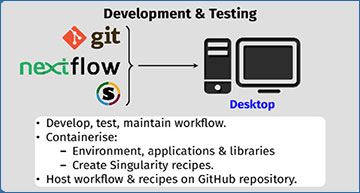The rate of raw sequence production through Next-Generation Sequencing (NGS) has been growing exponentially due to improved technology and reduced costs. This has enabled researchers to answer many biological questions through “multi-omics” data analyses. Even though such data promises new insights into how biological systems function and understanding disease mechanisms, computational analyses performed on such large datasets comes with its challenges and potential pitfalls.
Researchers from University of the Witwatersrand have developed a robust portable and reproducible bioinformatic pipeline for the automation of RNA sequencing (RNA-seq) data analyses. Using Nextflow as a workflow management system and Singularity for application containerisation, the nf-rnaSeqCount pipeline was developed for mapping raw RNA-seq reads to a reference genome and quantifying abundance of identified genomic features for differential gene expression analyses. The pipeline provides a quick and efficient way to obtain a matrix of read counts that can be used with tools such as DESeq2 and edgeR for differential expression analysis. Robust and flexible bioinformatic and computational pipelines for RNA-seq data analysis, from QC to sequence alignment and comparative analyses, will reduce analysis time, and increase accuracy and reproducibility of findings to promote transcriptome research.
Overall summary of the nf-rnaSeqCount pipeline
The nf-rnaSeqCount pipeline works in 4 stages: (1) Data Preparation: for downloading Singularity containers and indexing the reference genome using STAR and Bowtie; (2) Quality Control: for assessing the quality of RNA-seq reads using FastQC and trimming low quality bases using Trimmomatic; (3) Alignment & Quantification: for aligning reads to the reference genome using STAR and quantifying abundance of identified genomic features using featureCounts and htseq-count; (4) MultiQC: for assessing the quality of the steps in the pipeline using MultiQC. The main output for the nf-rnaSeqCount pipeline are read count matrices produced by featureCounts and htseq-count, as well as a QC report from MultiQC.
Mpangase PT, Frost J, Tikly M, Ramsay M, Hazelhurst S. (2022) nf-rnaSeqCount: A Nextflow pipeline for obtaining raw read counts from RNA-seq data. S Afr Comput J 33(2):830.[article]





